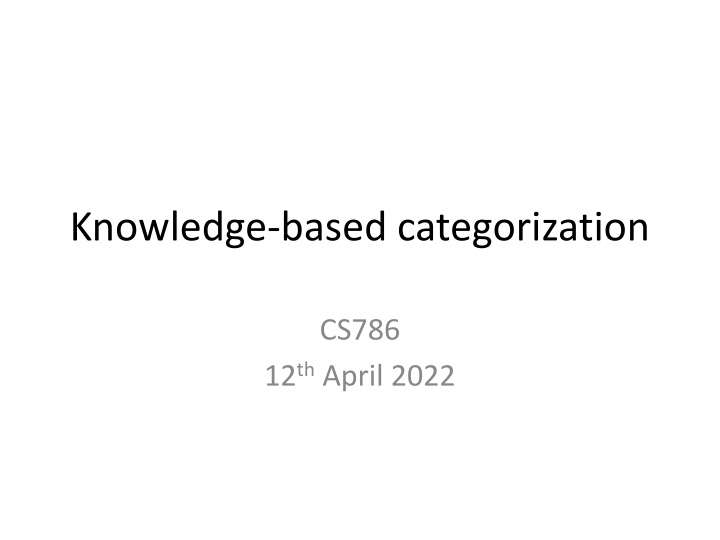
Knowledge-Based Categorization and Concept Learning Insights
Explore the impact of knowledge on concept learning through categories and exemplar models. Discover how background knowledge influences the classification of new elements and the learning mechanisms involved in supervised settings like ALCOVE. Optimization techniques, such as gradient descent, play a key role in refining model parameters for accurate categorization.
Download Presentation

Please find below an Image/Link to download the presentation.
The content on the website is provided AS IS for your information and personal use only. It may not be sold, licensed, or shared on other websites without obtaining consent from the author. If you encounter any issues during the download, it is possible that the publisher has removed the file from their server.
You are allowed to download the files provided on this website for personal or commercial use, subject to the condition that they are used lawfully. All files are the property of their respective owners.
The content on the website is provided AS IS for your information and personal use only. It may not be sold, licensed, or shared on other websites without obtaining consent from the author.
E N D
Presentation Transcript
Knowledge-based categorization CS786 12thApril 2022
Knowledge-based Views Murphy (2002, p. 183): Neither prototype nor exemplar models have attempted to account for knowledge effects . . . The problem is that these models start from a kind of tabula rasa [blank slate] representation, and concept representations are built up solely by experience with exemplars.
Effect of Knowledge on Concept Learning Concept learning experiment involving two categories of children s drawings Two learning conditions: neutral labels for categories (Group 1 vs. Group 2 children) Category labels induced use of background knowledge: Creative and non-creative children created category A and B drawings respectively Note: same stimuli are used in both conditions Palmeri & Blalock (2000)
By manipulating the meaningfulness of the labels applied to those categories of drawings, subjects classified new drawings in markedly different ways. E.g., neutral labels led to an emphasis of concrete features. The creative vs. non-creative labels led to an emphasis of abstract features Background knowledge and empirical information about instances closely interact during category learning Palmeri & Blalock (2000)
Learning an exemplar model from labels Original GCM model had no learning Parameters fit to data Basically just a clustering model (unsupervised) Later models offer learning mechanisms Kruschke s ALCOVE model (1992) Assumes a supervised learning setting Learner predicts categories Teacher teaches true category
Supervised learning in ALCOVE Activation of category k given stimulus y Training loss function Where t is a training label that is 1 if the predicted response is correct and 0 otherwise
Optimization using gradient descent All weights and parameters are learned using gradient descent Weight update Exemplar-wise error Attention update
Variations GCM-class models assume the presence of interval- scaled psychological distances Can make different assumptions about similarity function, e.g. categorical instead of continuous scale # of matches # of mismatches # matches - # mismatches Can make different assumptions about the learning mechanism Anderson s Rational Model of Categorization We will see this next
Categories of categorization models Prototype models assume people store singular prototypes New stimuli are categorized based on distance from psychological distance from prototype Exemplar models assume people store many examples New stimuli are categorized based on average distance from these exemplars Prototype Exemplars
What do people do? Let s look at an experiment by Smith & Minda (1998) Stimuli were 6 digit binary strings Category A 000000, 100000, 010000, 001000, 000100, 000001, 111101 Category B 111111, 011111, 101111, 110111, 111011, 111101, 111110, 000100 All 14 stimuli presented, randomly permuted, 40 times People asked to categorize into A and B, with feedback
What would a prototype model do? P(category A) Can t get the oddball category members right
What would an exemplar model do? p(category A) Doesn t learn across segments, because exemplars don t change
What do people actually do? p(category A) Start off as prototype models, but then self-correct
Problems Can t explain complex categorization Across linearly separable boundaries Can t capture effect of category variance Can t capture learning curves in categorization Can t explain complex categorization Across linearly separable boundaries Without a lot of ad hoc assumptions
Reality People behave as if they are storing prototypes sometimes Category judgments evolve over multiple presentations Sensible thing to do in situations where the category is not competing with others for membership People behave as if they are storing exemplars sometimes Probability matching behavior in describing category membership Sensible thing to do when discriminability at category boundaries becomes important Shouldn t we have models that can do both?
A Bayesian observer model of categorization Want to predict category label c of the Nth object, given All objects seen before and Their category labels Sequential Bayesian update Assumption: only category labels influence the prior. Can you think of situations when this would be broken?
Connection with classic models Remember the GCM category response calculation? Likelihood Prior Look at the numerator of the Bayesian model Prior Likelihood Let s call this likelihood LN,j
A unifying view In an exemplar model In a prototype model Crucial insight Prototype model is a clustering model with one cluster Exemplar model is a clustering model with N clusters https://hekyll.services.adelaide.edu.au/dspace/bitstream/2440/46850/1/hdl_46850.pdf
